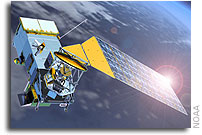Polar-Orbiting Operational Environmental Satellites: Restructuring Is Under Way, but Technical Challenges and Risks Remain

Restructuring Is Under Way, but Technical Challenges and Risks Remain
Full Report GAO-07-498, April 27
Why GAO Did This Study
The National Polar-orbiting Operational Environmental Satellite System (NPOESS) is a tri- agency acquisition–managed by the Departments of Commerce and Defense and the National Aeronautics and Space Administration–which experienced escalating costs, schedule delays, and technical difficulties. These factors led to a June 2006 decision to restructure the program thereby decreasing the program’s complexity, increasing its estimated cost to $12.5 billion, and delaying the first two satellites by 3 to 5 years. GAO was asked to (1) assess progress in restructuring the acquisition, (2) evaluate progress in establishing an effective management structure, (3) assess the reliability of the cost and schedule estimate, and (4) identify the status and key risks facing the program’s major segments. To do so, GAO analyzed program and contractor data, attended program reviews, and interviewed program officials.
What GAO Recommends
GAO recommends that the appropriate executives approve key acquisition documents, the Secretary of Defense delay reassigning the Program Executive, and the Secretary of Commerce ensure that program authorities identify and address staffing needs. Agency officials agreed with all of the recommendations except delaying the Program Executive’s reassignment. GAO believes that proceeding with this reassignment would increase program risks.
What GAO Found
The NPOESS program office has made progress in restructuring the acquisition by establishing and implementing interim program plans guiding the contractors’ work activities in 2006 and 2007; however, important tasks leading up to finalizing contract changes remain to be completed. Executive approvals of key acquisition documents are about 6 months late–due in part to the complexity of navigating three agencies’ approval processes. Delays in finalizing these documents could hinder plans to complete contract negotiations by July 2007 and could keep the program from moving forward in fiscal year 2008 with a new program baseline.
The program office has also made progress in establishing an effective management structure by adopting a new organizational framework with increased oversight from program executives and by instituting more frequent and rigorous program reviews; however, plans to reassign the recently appointed Program Executive Officer will likely increase the program’s risks. Additionally, the program lacks a process and plan for identifying and filling staffing shortages, which has led to delays in key activities such as cost estimating and contract revisions. Until this process is in place the NPOESS program faces increased risk of further delays.
The methodology supporting a June 2006 independent cost estimate with the expectation of initial satellite launch in January 2013 was reliable, but recent events could increase program costs and delay schedules. Specifically, the program continues to experience technical problems on key sensors and program costs will likely be adjusted during upcoming negotiations on contract changes. A new baseline cost and schedule reflecting these factors is expected by July 2007.
Development and testing of major NPOESS segments–including key sensors and ground systems–are under way, but significant risks remain. For example, while work continues on key sensors, two of them experienced significant problems and are considered high risk (see table). Additionally, while progress has been made in reducing delays in the data processing system, work remains in refining the algorithms needed to translate sensor observations into useable weather products. Given the tight time frames for completing this work, it will be important for program officials and executives to continue to provide close oversight of milestones and risks.
Key NPOESS Components and Corresponding Risk Levels
- NPOESS component – Risk level
- Visible/infrared imager radiometer suite – High
- Cross-track infrared sounder – High
- Ozone mapper/profiler suite – Moderate
- Advanced technology microwave sounder – Low
- Command, control, and communications system – Low
- Interface data processing system – Moderate
Source: GAO analysis of NPOESS Integrated Program Office data. www.gao.gov/cgi-bin/getrpt?GAO-07-498.








